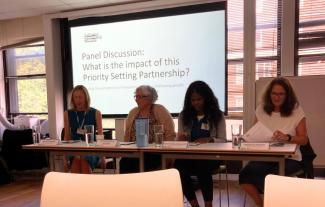Blog: Top 10 stammering research priorities

Catherine Woolley, STAMMA's Programme Lead for Children & Families, tells us about being involved in a project to find out what young people want from stammering research.
As someone with a Masters in Applied Research in Human Communication Disorders, I was thrilled to find one of my first jobs here at STAMMA back in 2021 was to be involved in a Priority Setting Partnership (PSP) led by Action for Stammering Children.
In partnership with the James Lind Alliance, the PSP aimed to bring together young people who stammer and those who support them (eg parents and Speech & Language Therapists) to find out what they thought the current gaps are in research into stammering and what they want researchers to study in the future. The goal was to come up with a shortlist of the top 10 research priorities.
How did we get to a top 10?
There were 5 main steps to the project:
- We invited people to share any questions they have about developmental stammering (stammering that starts in childhood as language develops). In total, people submitted 385 different questions about stammering.
- We then looked through all these questions to remove duplicates or combine questions which were asking the same thing, which left us with 50 summary questions.
- We explored the current literature to check whether existing research had already answered these questions.
- We then asked people to review the list of questions and choose which 10 they thought were the most important. They then had to rank their top 10 in order of priority for them. From this we identified the top 25 questions ranked by the public.
- Lastly, we held an in-person workshop where we reviewed and ranked the top 25 questions to create our final top 10 research priorities.
After nearly three years in the works, a few weeks ago, on the 18th of September 2024, I attended Action for Stammering Children's official launch event at University College London. The session explained how the PSP was developed and the impact that this project will have in the future for research into stammering. Then the priorities were announced. We found that the questions fell into a range of different categories, including learning more about the causes of stammering and support for people who stammer, and you can read them below.
The top 10 research priorities
- What are the most effective forms of speech therapy for children and young people who stammer to give the best long term outcomes?
- How can parents and family members best support children and young people who stammer? How can parents and family members best be trained and supported to do this?
- How can teachers in schools best support children and young people who stammer? How can teachers best be trained and supported to do this?
- What are the emotional and psychological impacts of stammering on children and young people who stammer (eg low self-esteem and depression)? How are these best treated and supported?
- What causes children to develop a stammer in early childhood?
- Are other brain-related conditions (eg autism and ADHD) linked to stammering? What impact do these have on stammering?
- What impact does stammering have on children's and young people's performance at school? How does this affect their prospects for further training, education and employment? What forms of support would be of most help?
- What is the most effective therapy and support for very young children who stammer (pre-school)?
- What triggers stammering to increase in children and young people in different situations (eg anxiety or excitement)? How is this best managed?
- How does a child's emotions and personality affect the impact of a stammer? Does helping a child to manage their emotions reduce the stammer and its impact?
But finding the top 10 is just the beginning! We want to get these top 10 priorities out there so that future research is based around what people who stammer want to know.
Want to learn more about the Priority Setting Partnership? Read Action for Stammering Children's report.

































